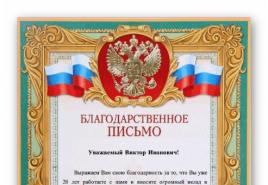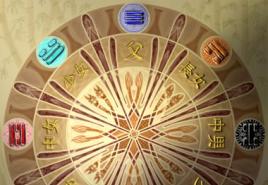What were the letters in Cyrillic called? Cyrillic alphabet. Cyrillic in Unicode
Russian writing has its own history of formation and its own alphabet, which is very different from the same Latin used in most European countries. The Russian alphabet is Cyrillic, or rather its modern, modified version. But let's not get ahead of ourselves.
So, what is Cyrillic? This is the alphabet that underlies some Slavic languages, such as Ukrainian, Russian, Bulgarian, Belarusian, Serbian, Macedonian. As you can see, the definition is quite simple.
The history of the Cyrillic alphabet begins in the 9th century, when the Byzantine Emperor Michael III ordered the creation of a new alphabet for the Slavs in order to convey religious texts to believers.
The honor of creating such an alphabet went to the so-called “Thessalonica brothers” - Cyril and Methodius.
But does this give us an answer to the question, what is the Cyrillic alphabet? Partly yes, but there are still some Interesting Facts. For example, the Cyrillic alphabet is an alphabet based on the Greek statutory letter. It is also worth noting that numbers were denoted using some letters of the Cyrillic alphabet. To do this, a special diacritic mark was placed above the combination of letters - the title.
As for the spread of the Cyrillic alphabet, it came to the Slavs only with For example, in Bulgaria the Cyrillic alphabet appeared only in 860, after it adopted Christianity. At the end of the 9th century, the Cyrillic alphabet penetrated into Serbia, and another hundred years later into the territory of Kievan Rus.

Along with the alphabet, church literature, translations of the Gospels, Bibles, and prayers began to spread.
In fact, from this it becomes clear what the Cyrillic alphabet is and where it came from. But has it reached us in its original form? Not at all. Like many things, writing has changed and improved along with our language and culture.
Modern Cyrillic has lost some of its symbols and letters during various reforms. So the following letters disappeared: titlo, iso, kamora, the letters er and er, yat, yus big and small, izhitsa, fita, psi and xi. The modern Cyrillic alphabet consists of 33 letters.
In addition, the alphabetic number has not been used for a long time; it has been completely replaced. The modern version of the Cyrillic alphabet is much more convenient and practical than the one that was a thousand years ago.
So, what is Cyrillic? Cyrillic is an alphabet created by the enlightenment monks Cyril and Methodius on the orders of Tsar Michael III. Having accepted the new faith, we received at our disposal not only new customs, a new deity and culture, but also an alphabet, a lot of translated church literature, which for a long time remained the only type of literature that the educated layers of the population of Kievan Rus could enjoy.

Over the course of time and under the influence of various reforms, the alphabet changed, improved, and extra and unnecessary letters and symbols disappeared from it. The Cyrillic alphabet that we use today is the result of all the metamorphoses that have occurred over more than a thousand years of the existence of the Slavic alphabet.
As you correctly noted here, we often hear the word Cyrillic, but at the same time we often forget what kind of letters these are and the very history of their origin, distribution in our country and among neighboring countries.
Cyrillic alphabet: origin and designations
Cyrillic is considered to be the very oldest alphabets in the whole world, in particular Eastern Europe, which was characteristic of the Slavic tribes. The basis of the alphabet already at the beginning of the ninth century AD It was the Byzantine letter that was based. The inventors of this letter wanted to convey Greek words in letters that were used in other languages.
These letters were introduced into circulation by Cyril and Methodius in Ancient Moravia (Balkan part of Europe).

The Cyrillic alphabet began to be used precisely by those nationalities that began to preach such a religion as Orthodoxy.
Today, writing based on Cyrillic letters is still used by Slavic peoples - Russians, all Belarusians and Ukrainians, Bulgarians, etc. Of course, the Cyrillic alphabet has gone through a stage of modernization and renewal, but still most of the letters still have a visible resemblance to the first letters of the ancient Cyrillic alphabet.
So, Cyrillic is an old Slavic letter (alphabet), which is now used by residents of Eastern and Central Europe.
You may want to print and cut out.letters for decoration.
The alphabet (Cyrillic and Glagolitic) is a collection in a certain order of all the signs that express the individual sounds of the language. This system written symbols received quite independent development in the territory inhabited by ancient peoples. "Glagolitic" was presumably created first. What is the secret of the ancient collection of written signs? What were the Glagolitic and Cyrillic alphabet? What is the meaning of the main symbols? More on this later.
The Mystery of the Written Symbol System
As you know, Cyrillic and Glagolitic are Slavic alphabets. The name of the collection itself was derived from the combination of “az” and “buki”. These symbols stood for the first two letters "A" and "B". A rather interesting historical fact should be noted. Ancient letters were originally scratched on the walls. That is, all the symbols were presented in the form of graffiti. Around the 9th century, the first symbols appeared on the walls of Pereslavl churches. Two centuries later, the Cyrillic alphabet (pictures and interpretations of signs) was inscribed in the St. Sophia Cathedral in Kyiv.
Russian Cyrillic
It should be said that this collection of ancient written symbols still corresponds well to the phonetic structure of the Russian language. This is primarily due to the fact that the sound composition of modern and ancient vocabulary did not have many differences, and all of them were insignificant. In addition, credit should be given to the compiler of the system, Konstantin. The author carefully took into account the phonemic (sound) composition of the old speech. The Cyrillic alphabet contains only a variety of characters - uppercase and lowercase characters - which were first introduced by Peter in 1710.

Basic signs
The Cyrillic letter "az" was the initial letter. She used the pronoun "I". But the root meaning of this symbol is the word “initially”, “beginning” or “begin”. In some writings you can find “az”, used in the meaning of “one” (as a numeral). The Cyrillic letter "buki" is the second character in the collection of symbols. Unlike "az", it has no numerical value. "Buki" is "to be" or "will be." But, as a rule, this symbol was used in the future tense. For example, “boudi” means “let it be,” and “upcoming or future” means “boudushchy.” The Cyrillic letter "vedi" is considered one of the most interesting of the entire collection. This symbol corresponds to the number 2. “Lead” has several meanings - “to own”, “to know” and “to know”.
The highest part of the written sign system
It should be said that researchers, studying the outlines of the symbols, came to the conclusion that they were quite simple and understandable, which made it possible to widely use them in cursive writing. In addition, any Slav could depict them quite easily, without much difficulty. Many philosophers, meanwhile, see the principle of harmony and triad in the numerical arrangement of symbols. It is precisely this that a person must achieve, striving to know truth, goodness and light.

Constantine's message to descendants
It should be said that the Cyrillic and Glagolitic alphabet were an invaluable creation. Constantine, together with his brother Methodius, not only structured written signs, but created a unique collection of knowledge that calls for striving for knowledge, improvement, love and wisdom, avoiding enmity, anger, envy, and leaving only the bright in oneself. At one time it was believed that the Cyrillic and Glagolitic alphabet were created almost simultaneously. However, this turned out not to be the case. According to a number of ancient sources, the Glagolitic alphabet became the first. It was this collection that was first used in the translation of church texts.
Glagolitic and Cyrillic. Comparison. Data
Cyrillic and Glagolitic alphabet were created in different time. Several facts indicate this. The Glagolitic alphabet, along with the Greek alphabet, became the basis for the subsequent compilation of the Cyrillic alphabet. When studying the first collection of written characters, scientists note that the style is more archaic (in particular, when studying the “Kyiv Leaflets” of the 10th century). While the Cyrillic alphabet, as mentioned above, is phonetically closer to modern language. The first records in the form of graphic representations of written symbols are dated 893 and are close to the sound and lexical structure of the language of the southern ancient peoples. The great antiquity of the Glagolitic alphabet is also indicated by palimpsests, which were manuscripts on parchment, where the old text was scraped off and a new one was written on top. The Glagolitic alphabet was scraped off everywhere, and then Cyrillic was written on top of it. In no palimpsest was it the other way around.

Attitude of the Catholic Church
There is information in the literature that the first collection of written symbols was compiled by Constantine the Philosopher on one ancient runic script. It is believed that it could have been used by the Slavs for secular and sacred pagan purposes before Christianity was adopted. But, however, there is no evidence of this, nor, in fact, confirmation of the existence of runic writing. Rimskaya, who opposed holding services in the Slavic language for the Croats, characterized the Glagolitic alphabet as a “Gothic letter.” Some ministers openly opposed the new alphabet, saying that it was invented by the heretic Methodius, who “in that Slavic language wrote many lies against the Catholic religion.”
The appearance of the symbols
The letters of the Glagolitic and Cyrillic alphabet differed from each other in style. In the earlier written system, the appearance of the signs in some points coincides with the khutsuri created before the 9th century, possibly based on the Armenian). The number of letters in both alphabet is the same - 38. Some individual symbols and the entire system of “finishing” small circles at the ends of lines, in general, have a pronounced resemblance to Jewish medieval Kabbalistic fonts and “runic” Icelandic cryptography. All these facts may not be accidental at all, since there is information that Constantine the Philosopher read ancient Jewish texts in the original, that is, he was familiar with Eastern writings (this is stated in his “life”). The style of almost all Glagolitic letters, as a rule, is derived from Greek cursive. For non-Greek characters, the Hebrew system is used. But meanwhile, there are no exact and specific explanations for the outline of forms for almost any symbol.

Similarities and differences
The Cyrillic and Glagolitic alphabets in their oldest versions are almost completely identical in composition. Only the forms of the characters are different. When reprinting Glagolitic texts by typography, the characters are replaced with Cyrillic ones. This is primarily due to the fact that today few people can recognize the more ancient mark. But when replacing one alphabet with another, the digital values of the letters do not match. In some cases this leads to misunderstandings. So, for example, in the Glagolitic alphabet the numbers correspond to the order of the letters themselves, and in the Cyrillic alphabet the numbers are tied to those in the Greek alphabet.
The purpose of ancient writing
As a rule, they talk about two types of Glagolitic writing. A distinction is made between the older “round” one, also known as “Bulgarian”, and the later “angular” or “Croatian” (so named because it was used in worship by Croatian Catholics until the very middle of the 20th century). The number of characters in the latter was gradually reduced from 41 to 30 characters. In addition, there was (together with the statutory book) cursive writing. The Glagolitic alphabet was practically not used - in some cases there are separate “interspersions” of Glagolitic text fragments into Cyrillic ones. The ancient letter was primarily intended for the transmission (translation) of church meetings, and the surviving early Russian monuments of everyday writing before the adoption of Christianity (the oldest inscription is considered to be the inscription of the 1st half of the 10th century on a pot found on the Gnezdovo mound) are written in Cyrillic .

Theoretical assumptions about the primacy of the creation of ancient writing
Several facts support the fact that the Cyrillic and Glagolitic alphabets were created at different times. Moreover, the first was created on the basis of the second. The oldest monument is written in Glagolitic alphabet. Later finds contain more advanced texts. Cyrillic manuscripts, in addition, are copied from Glagolitic ones in a number of ways. In the first, grammar, spelling and syllables are presented in a more perfect form. When analyzing handwritten texts, a direct dependence of the Cyrillic alphabet on the Glagolitic alphabet is visible. Thus, the letters of the latter were replaced by similar ones in sound. When studying more modern texts, chronological errors are observed. This is due to the fact that the Cyrillic and Glagolitic alphabets assumed a different system of numerical correspondences. The digital values of the first were focused on Greek writing.
What system of written signs did Constantine compile?
According to a number of authors, it was believed that the Philosopher first composed the Glagolitic alphabet, and then, with the help of his brother Methodius, the Cyrillic alphabet. However, there is information that refutes this. Konstantin knew and loved the Greek language very much. In addition, he was a missionary of the Orthodox Eastern Church. At that time, his tasks included attracting the Slavic people to the Greek Church. In this regard, it made no sense for him to create a written system that would alienate nationalities and complicate the perception and understanding of Scripture by those who were already familiar with the Greek language. After the creation of a new, more advanced writing system, it was difficult to imagine that ancient archaic writing would become more popular. The Cyrillic alphabet was more understandable, simple, beautiful and clear. It was convenient for most people. While the Glagolitic alphabet had a narrow focus and was intended for the interpretation of sacred liturgical books. All this indicates that Constantine was preparing a system based on Greek. And subsequently, the Cyrillic alphabet, as a more convenient and simpler system, replaced the Glagolitic alphabet.

Opinions of some researchers
Sreznevsky in 1848 wrote in his writings that, evaluating the features of many Glagolitic symbols, one can conclude: this letter is more archaic, and the Cyrillic alphabet is more perfect. The relationship of these systems can be traced in some letterforms and sounds. But at the same time, the Cyrillic alphabet has become simpler and more convenient. In 1766, Count Klement Grubisich published a book about the origin of written sign systems. In his work, the author claims that the Glagolitic alphabet was created long before Christmas and is therefore a much more ancient collection of characters than the Cyrillic alphabet. Around 1640, Rafail Lenakovich wrote a “dialogue”, where he states almost the same as Grubisich, but almost 125 years earlier. There are also statements by Chernoriz the Brave (early 10th century). In his work “On Writing,” he emphasizes that the Cyrillic and Glagolitic alphabets have significant differences. In his texts, Chernoriz the Brave testifies to the existing dissatisfaction with the system of written signs created by the brothers Constantine and Methodius. At the same time, the author quite clearly indicates that it was a Cyrillic alphabet, not a Glagolitic alphabet, saying that the first was created before the second. Some researchers, assessing the outline of some characters ("ш", for example), draw conclusions different from those described above. So, according to some authors, the Cyrillic alphabet was created first, and only then the Glagolitic alphabet.
Conclusion
Despite enough a large number of Controversial opinions regarding the appearance of the Glagolitic and Cyrillic alphabet, the significance of the compiled system of written characters is enormous. Thanks to the appearance of a collection of handwritten signs, people were able to read and write. In addition, the work of the brothers Constantine and Methodius was an invaluable source of knowledge. Along with the alphabet, it was formed literary language. Many words are still found today in various related dialects - Russian, Bulgarian, Ukrainian and other languages. Together with new system written symbols also changed the perception of people of antiquity - after all, the creation of the Slavic alphabet was closely connected with the adoption and spread of the Christian faith, the rejection of ancient primitive cults.
Cyrillic alphabet- linguistic In the 9th century AD, Saints Cyril and Methodius created two alphabets, Glagolitic and Cyrillic, to write the Old Church Slavonic language. Cyrillic, based on Glagolitic and Greek alphabets, eventually became the system of choice... ... Universal additional practical Dictionary I. Mostitsky
Cyrillic alphabets Slavic: Belarusian alphabet Bulgarian alphabet Serbian alphabet ... Wikipedia
Cyrillic alphabets ... Wikipedia
Cyrillic alphabets Slavic: Belarusian alphabet Bulgarian alphabet Serbian alphabet ... Wikipedia
ALPHABET- [Greek ἀλφάβητος from the names of the first 2 letters of the Greek. alphabet: “alpha” and “beta” (“vita”)], a system of written letter signs that reflects and records the sound structure of the language and is the basis of writing. A. includes: 1) letters in their basic styles,... ... Orthodox Encyclopedia
Alphabet- (alphabet), a phonological writing system in which graphic signs (letters) indicate the corresponding sounds of the language. In one type of A., so-called. consonantal, letters indicate only consonant sounds, and vowels are expressed as diacritics... ... Peoples and cultures
Alphabet- from the name the first two letters of the Greek. A. alpha and beta (modern Greek vita), a set of letters adopted in the class. writing and located in the installation. ok; the same as the alphabet. In letters in monuments the word has been used since the 16th century, in modern times. lit. language b.... ... Russian humanitarian encyclopedic Dictionary
- (Chuvash. chӑvash alphavichӗ) the general name of the alphabets, the letters of which were used to convey elements of sound speech in the writing of the ancient Chuvash and modern Chuvash languages. In the Chuvash writing system, only alphabetic ones were used... ... Wikipedia
Introduction
Cyrillic - Slavic writing
In Rus' Slavic alphabet, mainly in the form of the Cyrillic alphabet, appears shortly before the adoption of Christianity. The first records were related to the economic and, perhaps, foreign policy activities of the recently emerged large state. The first books contained a record of Christian liturgical texts.
The literary language of the Slavs has reached us, recorded in handwritten monuments in two alphabets - Glagolitic and Cyrillic. The word "glagolitic" can be translated by the word "little letter" and means the alphabet in general. The term "Cyrillic" may mean "the alphabet invented by Cyril", but the great antiquity of this term has not been proven. Manuscripts from the era of Constantine and Methodius have not reached us. The earliest Glagolitic text is the Kyiv leaves (X century), Cyrillic - an inscription in Preslav in 931.
In terms of letter composition, the Cyrillic and Glagolitic alphabets are almost identical. The Cyrillic alphabet, according to manuscripts from the 11th century, had 43 letters. It was based on the Greek alphabet. For sounds that are the same in Slavic and Greek, Greek letters were used. For sounds unique to the Slavic language, 19 signs of a simple form, convenient for writing, were created, which corresponded to the general graphic style of the Cyrillic alphabet.
The Cyrillic alphabet took into account and correctly conveyed the phonetic composition of the Old Church Slavonic language. However, the Cyrillic alphabet had one major drawback: it included six Greek letters that were not needed to convey Slavic speech.
1. Cyrillic. Emergence and development
Cyrillic is one of the two ancient Slavic alphabets, which formed the basis of the Russian and some other Slavic alphabets.
Around 863, the brothers Constantine (Cyril) the Philosopher and Methodius from Soluni (Thessaloniki), by order of the Byzantine Emperor Michael III, streamlined the writing system for the Slavic language and used the new alphabet to translate Greek religious texts into the Slavic language. For a long time, the question remained debatable whether it was the Cyrillic alphabet (and in this case, Glagolitic is considered a secret script that appeared after the ban on the Cyrillic alphabet) or Glagolitic - alphabets that differ almost exclusively in style. Currently, the prevailing point of view in science is that the Glagolitic alphabet is primary, and the Cyrillic alphabet is secondary (in the Cyrillic alphabet, Glagolitic letters are replaced by well-known Greek ones). Glagolitic long time it was used in a slightly modified form by the Croats (until the 17th century).
The appearance of the Cyrillic alphabet, based on the Greek statutory (solemn) letter - uncial, is associated with the activities of the Bulgarian school of scribes (after Cyril and Methodius). In particular, in the life of St. Clement of Ohrid directly writes about his creation of Slavic writing after Cyril and Methodius. Thanks to the previous activities of the brothers, the alphabet became widespread in the South Slavic lands, which led in 885 to the prohibition of its use in church services by the Pope, who was struggling with the results of the mission of Constantine-Cyril and Methodius.
In Bulgaria, the holy king Boris converted to Christianity in 860. Bulgaria becomes the center of the spread of Slavic writing. Here the first Slavic book school was created - the Preslav Book School - the Cyril and Methodius originals of liturgical books (Gospel, Psalter, Apostle, church services) were copied, new Slavic translations from Greek were made, original works appeared in the Old Slavonic language (“On the writing of the Chrnoritsa Khrabra” ).
The widespread use of Slavic writing, its “golden age,” dates back to the reign of Tsar Simeon the Great (893-927), son of Tsar Boris, in Bulgaria. Later, the Old Church Slavonic language penetrates Serbia, and at the end of the 10th century it becomes the language of the church in Kievan Rus.
The Old Church Slavonic language, being the language of the church in Rus', was influenced by the Old Russian language. It was the Old Slavonic language of the Russian edition, as it included elements of living East Slavic speech.
Initially, the Cyrillic alphabet was used by some of the southern Slavs, East Slavs, as well as Romanians; Over time, their alphabets diverged somewhat from each other, although the style of letters and the principles of spelling remained (with the exception of the Western Serbian version, the so-called bosančica) generally the same.
The composition of the original Cyrillic alphabet is unknown to us; The “classical” Old Church Slavonic Cyrillic alphabet of 43 letters probably partly contains later letters (ы, оу, iotized). The Cyrillic alphabet entirely includes the Greek alphabet (24 letters), but some purely Greek letters (xi, psi, fita, izhitsa) are not in their original place, but are moved to the end. To these were added 19 letters to represent sounds specific to the Slavic language and absent in Greek. Before the reform of Peter I, there were no lowercase letters in the Cyrillic alphabet; all text was written in capitals. Some letters of the Cyrillic alphabet, absent in the Greek alphabet, are close in outline to Glagolitic ones. Ts and Sh are externally similar to some letters of a number of alphabets of that time (Aramaic letter, Ethiopic letter, Coptic letter, Hebrew letter, Brahmi) and it is not possible to unambiguously establish the source of the borrowing. B is similar in outline to V, Shch to Sh. The principles of creating digraphs in the Cyrillic alphabet (И from ЪІ, УУ, iotized letters) generally follow the Glagolitic ones.
Cyrillic letters are used to write numbers exactly according to the Greek system. Instead of a pair of completely archaic signs - sampia stigma - which are not even included in the classical 24-letter Greek alphabet, other Slavic letters are adapted - C (900) and S (6); subsequently, the third such sign, koppa, originally used in the Cyrillic alphabet to denote 90, was replaced by the letter Ch. Some letters that are not in the Greek alphabet (for example, B, Zh) do not have a numerical value. This distinguishes the Cyrillic alphabet from the Glagolitic alphabet, where the numerical values did not correspond to the Greek ones and these letters were not skipped.
The letters of the Cyrillic alphabet have their own names, based on various common Slavic names that begin with them, or directly taken from Greek (xi, psi); The etymology of some names is controversial. Judging by the ancient abecedarii, the letters of the Glagolitic alphabet were also called the same way. [Application]
In 1708-1711 Peter I undertook a reform of Russian writing, eliminating superscripts, abolishing several letters and legitimizing another (closer to the Latin fonts of that time) style of the remaining ones - the so-called civil font. Lowercase versions of each letter were introduced; before that, all letters of the alphabet were capitalized. Soon the Serbs switched to the civilian script (with appropriate changes), and later the Bulgarians; Romanians, in the 1860s, abandoned the Cyrillic alphabet in favor of Latin writing (interestingly, at one time they used a “transitional” alphabet, which was a mixture of Latin and Cyrillic letters). We still use a civil font with minimal changes in style (the largest is the replacement of the m-shaped letter “t” with its current form).
Over three centuries, the Russian alphabet has undergone a number of reforms. The number of letters generally decreased, with the exception of the letters “e” and “y” (used earlier, but legalized in the 18th century) and the only “author’s” letter - “e”, proposed by Princess Ekaterina Romanovna Dashkova. The last major reform of Russian writing was carried out in 1917-1918, resulting in the modern Russian alphabet, consisting of 33 letters.
At the moment, the Cyrillic alphabet is used as the official alphabet in the following countries: Belarus, Bosnia and Herzegovina, Bulgaria, Macedonia, Russia, Serbia, Ukraine, Montenegro, Abkhazia, Kazakhstan, Kyrgyzstan, Mongolia, Transnistria, Tajikistan, South Ossetia. The Cyrillic alphabet of non-Slavic languages was replaced by the Latin alphabet in the 1990s, but is still used unofficially as a second alphabet in the following states: Turkmenistan, Uzbekistan.







